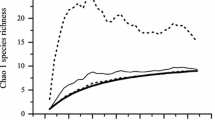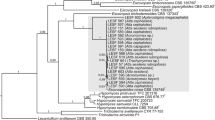Abstract
Insect-associated microbes exhibit a wide range of interactions with their hosts. One example of such interactions is the insect-driven dispersal of microorganisms, which plays an essential role in the ecology of several microbes. To study dispersal of microorganisms by leaf-cutting ants (Formicidae: Attini), we applied culture-dependent methods to identify the filamentous fungi and yeasts found in two different body parts of leaf-cutting ant gynes: the exoskeleton and the infrabuccal pocket. The gynes use the latter structure to store a pellet of the ants’ symbiotic fungus during nest founding. Many filamentous fungi (n = 142) and yeasts (n = 19) were isolated from the gynes’ exoskeleton. In contrast, only seven filamentous fungi and three yeasts isolates were recovered from the infrabuccal pellets, suggesting an efficient mechanism utilized by the gynes to prevent contamination of the symbiotic fungus inoculum. The genus Cladosporium prevailed (78%) among filamentous fungi whereas Aureobasidium, Candida and Cryptococcus prevailed among yeasts associated with gynes. Interestingly, Escovopsis, a specialized fungal pathogen of the leaf-cutting ant-fungus symbiosis, was not isolated from the body parts or from infrabuccal pellets of any gynes sampled. Our results suggest that gynes of the leaf-cutter ants Atta laevigata and A. capiguara do not vertically transmit any particular species of yeasts or filamentous fungi during the foundation of a new nest. Instead, fungi found in association with gynes have a cosmopolitan distribution, suggesting they are probably acquired from the environment and passively dispersed during nest foundation. The possible role of these fungi for the attine ant–microbial symbiosis is discussed.

Similar content being viewed by others
References
Almeida JMGCF (2005) Yeast community survey in the Tagus estuary. FEMS Microbiol Lett 53:295–303
Altschul SF, Madden TL, Schäffer AA, Zhang J, Zhang Z, Miller W et al (1997) Gapped BLAST and PSI-BLAST: a new generation of protein database search programs. Nucleic Acids Res 25:3389–3402. doi:10.1093/nar/25.17.3389
Autuori M (1941) Contribuição para o conhecimento da saúva (Atta spp.–Hymenoptera: Formicidae). I–Evolução do sauveiro (Atta sexdens rubropilosa Forel, 1908). Arq Inst Biol (São Paulo) 12:197–228
Ba AS, Phillips SA Jr (1996) Yeast biota of the red imported fire ant. Mycol Res 100:740–746
Ba AS, Phillips SA, Anderson JT (2000) Yeasts in the mound soil of the red imported fire ant. Mycol Res 104:969–973. doi:10.1017/S0953756299002385
Barnett JA, Payne RW, Yarrow D (2000) Yeasts: characteristics and identification, 2nd edn. Cambridge University Press, Cambrigde
Berkov A, Feinstein J, Small J, Nkmany M, Centeno P (2007) Yeasts isolated from neotropical wood-boring beetles in SE Peru. Biotropica 39:530–538. doi:10.1111/j.1744-7429.2007.00280.x
Bueno OC, Hebling MJA, Schneider MO, Pagnocca FC, Bacci M Jr (2002) Occurrence of winged forms of Atta sexdens rubropilosa Forel (Hymenoptera: Formicidae) in laboratory colonies. Neotrop Entomol 31:469–473. doi:10.1590/S1519-566X2002000300019
Cafaro MJ, Currie CR (2005) Phylogenetic analysis of mutualistic filamentous bacteria associated with fungus-growing ants. Can J Microbiol 51:441–446. doi:10.1139/w05-023
Carreiro SC (2000) Pesquisa do fator killer e análise de degradação de polissacarídeos vegetais por leveduras associadas aos ninhos de Atta sexdens. Ph.D. dissertation, Universidade Estadual Paulista
Carreiro SC, Pagnocca FC, Bueno OC, Bacci M Jr, Hebling MJA, Silva OA (1997) Yeasts associated with nests of the leaf-cutting ant Atta sexdens rubropilosa Forel, 1908. Antonie Van Leeuwenhoek 71:243–248. doi:10.1023/A:1000182108648
Carreiro SC, Pagnocca FC, Bacci M Jr, Lachance MA, Bueno OC, Hebling MJA et al (2004) Sympodiomyces attinorum sp. nov., a yeast species associated with nests of the leaf-cutting ant Atta sexdens. Int J Syst Evol Microbiol 54:1891–1894. doi:10.1099/ijs.0.63200-0
Chapela IH, Rehner SA, Schultz TR, Mueller UG (1994) Evolutionary history of the symbiosis between fungus-growing ants and their fungi. Science 266:1691–1694. doi:10.1126/science.266.5191.1691
Cooper CR, Ginnis Mc (1996) In vitro susceptibility of clinical yeast isolates to fluconazole and terconazole. Am J Obstet Gynecol 175:1626–1631. doi:10.1016/S0002-9378(96)70116-3
Craven SE, Dix MW, Michaels GE (1970) Attine fungus gardens contains yeasts. Science 169:184–186
Currie CR (2001a) A community of ants, fungi and bacteria: A multilateral approach to studying symbiosis. Annu Rev Microbiol 55:357–380. doi:10.1146/annurev.micro.55.1.357
Currie CR (2001b) Prevalence and impact of a virulent parasite on a tripartite mutualism. Oecologia 128:99–106. doi:10.1007/s004420100630
Currie CR, Mueller UG, Malloch D (1999a) The agricultural pathology of ant fungus gardens. Proc Natl Acad Sci USA 96:7998–8002. doi:10.1073/pnas.96.14.7998
Currie CR, Scott JA, Summerbell RC, Malloch D (1999b) Fungus-growing ants use antibiotic-producing bacteria to control garden parasites. Nature 398:701–704. doi:10.1038/19519
Currie CR, Bot ANM, Boomsma JJ (2003a) Experimental evidence of a tripartite mutualism: bacteria protect ant fungus gardens from specialized parasites. Oikos 101:91–102. doi:10.1034/j.1600-0706.2003.12036.x
Currie CR, Scott JA, Summerbell RC, Malloch D (2003b) Corrigendum: Fungus-growing ants use antibiotic-producing bacteria to control garden parasites. Nature 423:461. doi:10.1038/nature01563
Currie CR, Wong B, Stuart AE, Schultz TR, Rehner SA, Mueller UG et al (2003c) Ancient tripartite co-evolution in the attine ant–microbe symbiosis. Science 299:386–388. doi:10.1126/science.1078155
Domsch KH, Gams W, Anderson T (1980) Compendium of soil fungi. Academic, London
Fonseca A, Inácio J (2006) Phylloplane yeasts. In: Rosa CA, Péter G (eds) The yeast handbook: biodiversity and ecophysiology of yeasts. Springer Verlag, Berlin, pp 263–301
Ganter PF (2006) Yeasts and invertebrates associations. In: Rosa CA, Péter G (eds) The yeast handbook: biodiversity and ecophysiology of yeasts. Springer Verlag, Berlin, pp 263–301
Hall TA (1999) BioEdit: a user-friendly biological sequence alignment editor and analysis program for Windows 95/98/NT. Nucleic Acids Symp Ser 41:95–98
Kocsube S, Toth M, Vagvolgyi C, Doczi I, Pesti M, Pocsi I et al (2007) Occurrence and genetic variability of Candida parapsilosis sensu lato in Hungary. J Med Microbiol 56:190–195. doi:10.1099/jmm.0.46838-0
Kost C, Lakatos T, Böttcher I, Arendholz WR, Redenbach M, Wirth R (2007) Non-specific association between filamentous bacteria and fungus-growing ants. Naturwissenschaften 94:821–828. doi:10.1007/s00114-007-0262-y
Kurtzman CP, Fell JW (1998) The yeasts: a taxonomic study, 4th edn. Elsevier, Amsterdam
Kurtzman CP, Robnett CJ (1998) Identification and phylogeny of ascomycetous yeasts from analysis of nuclear large subunit (26S) rDNA partial sequences. Antonie Van Leeuwenhoek 73:331–371. doi:10.1023/A:1001761008817
Little AEF, Currie CR (2007) Symbiont complexity: discovery of a fifth symbiont in the attine ant-microbe symbiosis. Biol Lett 3:501–504. doi:10.1098/rsbl.2007.0253
Liu XY, Huang H, Zheng RY (2001) Relationships within Cunninghamella based on sequence analysis of ITR rDNA. Mycotaxon 80:77–95
Mankowski ME, Morrell JJ (2004) Yeasts associated with the infrabuccal pocket and colonies of the carpenter ant Camponotus vicinus. Mycologia 96:226–231. doi:10.2307/3762058
Middelhoven WJ, Fonseca A, Carreiro SC, Pagnocca FC, Bueno OC (2003) Cryptococcus haglerorum, sp. nov., an anamorphic basidiomycetous yeast isolated from nests of the leaf-cutting ant Atta sexdens. Antonie Van Leeuwenhoek 83:167–174. doi:10.1023/A:1023384830802
Moser JC (1967) Mating activities of Atta texana (Hymenoptera: Formicidae). Insect Soc 14:295–312. doi:10.1007/BF02252831
Mueller UG (2002) Ant versus fungus versus mutualism: ant-cultivar conflict and the deconstruction of the attine ant-fungus symbiosis. Am Nat 160:S67–S98
Mueller UG, Rehner SA, Schultz TR (1998) The evolution of agriculture in ants. Science 281:2034–2038. doi:10.1126/science.281.5385.2034
O`Donnel K (1993) Fusarium and its near relatives. In: Reynolds DR, Taylor JW (eds) The fungal holomorph: mitotic and pleomorphic speciation in fungal systematics. CAB International, Wallingford, pp 225–233
Pagnocca FC, Carreiro SC, Bueno OC, Hebling MJ, da Silva OA (1996) Microbiological changes in the nests of leaf-cutting ants fed on sesame leaves. J Appl Entomol 120:317–320
Pagnocca FC, Bacci M Jr, Fungaro MH, Bueno OC, Hebling MJA, Sant’Anna A et al (2001) RAPD analysis of the sexual state and sterile mycelium of the fungus cultivated by the leaf-cutting ant Acromyrmex hispidus fallax. Mycol Res 105:173–176. doi:10.1017/S0953756200003191
Phaff J, Starmer WT (1987) Yeast associated with plants, soil and insects. In: Rose AH, Harrinson JS (eds) The yeast: biology of yeast. Academic Press, London, pp 123–180
Quinlan RJ, Cherrett JM (1978) Studies on the role of the infrabuccal pocket of the leaf-cutting ant Acromyrmex octospinosus (Reich) (Hym., Formicidae). Insectes Soc 25:237–245. doi:10.1007/BF02224744
Rodrigues A, Pagnocca FC, Bacci M Jr, Hebling MJA, Bueno OC, Pfenning LH (2005) Variability of non-mutualistic filamentous fungi associated with Atta sexdens rubropilosa nests. Folia Microbiol (Praha) 50:421–425
Rodrigues A, Bacci M Jr, Mueller UG, Ortiz A, Pagnocca FC (2008) Microfungal “weeds” in the leafcutter ant symbiosis. Microb Ecol doi:10.1007/s00248-008-9380-0
Rosa CA, Morais PB, Santos SR, Neto PRP, Mendonça-Hagler LC, Hagler AN (1995) Yeast communities associated with different plant resources in sandy coastal plains of south eastern Brazil. Mycol Res 99:1047–1054
Rosa CA, Lachance M-A, Silva JOC, Teixeira ACP, Marini MM, Antonini Y et al (2003) Yeast communities associated with stingless bees. FEMS Yeast Res 4:271–275. doi:10.1016/S1567-1356(03)00173-9
Samson RA, Hoekstra ES, Frisvad JC (2000) Introduction to food-airborne fungi, 6th edn. Centraalbureau voor Schimmelcultures, Baarn
Santos AV, Dillon RJ, Dillon VM, Reynolds SE, Samuels RI (2004) Occurrence of the antibiotic producing bacterium Burkholderia sp. in colonies of the leaf-cutting ant Atta sexdens rubropilosa. FEMS Microbiol Lett 239:319–323. doi:10.1016/j.femsle.2004.09.005
Schubert K, Groenewald JZ, Braun U, Dijksterhuis J, Starink M, Hill CF et al (2007) Biodiversity in the Cladosporium herbarum complex (Davidiellaceae, Capnodiales), with standardisation of methods for Cladosporium taxonomy and diagnostics. Stud Mycol 58:105–156
Schultz TR, Brady SG (2008) Major evolutionary transitions in ant agriculture. Proc Natl Acad Sci USA doi:10.1073/pnas.0711024105
Schultz TR, Meier R (1995) A phylogenetic analysis of the fungus-growing ants (Formicidae: Attini) based on morphological characters of the larvae. Syst Entomol 20:337–370. doi:10.1111/j.1365-3113.1995.tb00100.x
Silva A, Bacci M Jr, Pagnocca FC, Bueno OC, Hebling MJA (2006) Starch metabolism in Leucoagaricus gongylophorus, the symbiotic fungus of leaf-cutting ants. Microbiol Res 161:299–303. doi:10.1016/j.micres.2005.11.001
Six DL, Klepzig KD (2004) Dendroctonus bark beetles as model systems for studies on symbiosis. Symbiosis 37:207–232
Slaviková E, Vadkertiová R (2000) The occurrence of yeasts in the forest soils. J Basic Microbiol 40:207–212. doi :10.1002/1521-4028(200007)40:3<207::AID-JOBM207>3.0.CO;2-H
Suh S-O, McHugh JV, Pollock DD, Blackwell M (2005) The beetle gut: a hyperdiverse source of novel yeasts. Mycol Res 109:261–265. doi:10.1017/S0953756205002388
Sun B-D, Liu X-Z (2008) Occurrence and diversity of insect-associated fungi in natural soils in China. Appl Soil Ecol 39:100–108. doi:10.1016/j.apsoil.2007.12.001
Villensen P, Mueller UG, Schultz TR, Adams RMM, Bouck AC (2004) Evolution of ant-cultivar specialization and cultivar switching in Apterostigma fungus-growing ants. Evolution Int J Org Evolution 58:2252–2265
Weber NA (1972) Gardening ants: the attines. American Philosophical Society, Philadelphia
Wetterer JK, Schultz TR, Meier R (1998) Phylogeny of fungus-growing ants (Tribe Attini) based on mtDNA sequence and morphology. Mol Phylogenet Evol 9:42–47. doi:10.1006/mpev.1997.0466
Yarrow D (1998) Methods for the isolation, maintenance and identification of yeasts. In: Kurtzman CP, Fell JW (eds) The yeasts: a taxonomic study. Elsevier, Amsterdam, pp 77–100
Acknowledgments
We are grateful to the “Conselho Nacional de Desenvolvimento Científico e Tecnológico” (CNPq–Proc. 301713/2005-7 and 479990/2006-9) and “Fundação de Amparo a Pesquisa do Estado de São Paulo” (FAPESP–Proc. 50139/4-2007 and 08/00185-7) for financial support. We also like to thank Dr. Scott E. Solomon from The University of Texas at Austin for his valuable review of this manuscript and Dr. Luiz Carlos Forti from the Department of Vegetal Production, UNESP - São Paulo State University for providing the facilities during field collection.
Author information
Authors and Affiliations
Corresponding author
Rights and permissions
About this article
Cite this article
Pagnocca, F.C., Rodrigues, A., Nagamoto, N.S. et al. Yeasts and filamentous fungi carried by the gynes of leaf-cutting ants. Antonie van Leeuwenhoek 94, 517–526 (2008). https://doi.org/10.1007/s10482-008-9268-5
Received:
Accepted:
Published:
Issue Date:
DOI: https://doi.org/10.1007/s10482-008-9268-5




